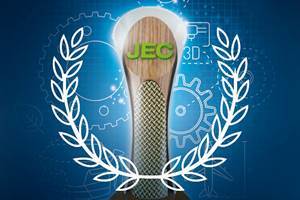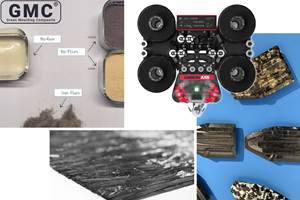JEC Composites Startup Booster 2025 finalists are revealed
Out of more than 100 submitted applications, the following 20 finalists have been chosen to pitch their composites innovation at JEC World 2025.
Since its initiation in 2017, the JEC Composites Startup Booster has quickly become a global reference for entrepreneurship in the composites industry. For 2025’s competition, JEC Group reports more than 100 entrepreneurs, startups and university spin-offs submitted applications, with 20 selected as finalists. In Paris, France, from March 4-6, finalists will have the opportunity to present their projects before an expert jury on the JEC World stage.
The JEC Composites Startup Booster provides a networking opportunity, offering increased visibility into the future of the composites industry. Held in three regions (Europe, the U.S. and Asia), the competition has already fostered the emergence of more than 900 innovative projects from more than 60 countries. It has become an essential springboard for participants seeking international opportunities.
This year, the competition is organized with sponsorship from Airbus, Proxxima (an ExxonMobil product) and Owens Corning as the main innovation partners, and Mercedes-Benz and Swancor as innovation partners.
Following the application process, two pitch sessions — each featuring 10 presentations — will take place on the Agora stage (Hall 6):
- Tuesday, March 4, at 10:00 a.m. for the “Products & Materials” category
- Tuesday, March 4, at 4:30 p.m. for the “Processes, Manufacturing and Equipment” category
Three winners will be designated by the jury, along with one winner for the sustainable dimension of the project. The award ceremony will take place on Wednesday, March 5, at 5:30 p.m. in Agora 6.
The jury includes:
- Jelle Bloemhof, head of composites manufacturing technologies at Airbus
- Markus Bold, managing director of Chemovator (BASF)
- Karl-Heinz Fueller, manager future exterior and materials, Mercedes-Benz
- Chris Hsieh, assistant VP at Swancor Holding
- Smita Kacker, opportunity development manager, new market development for ExxonMobil
- Claude-Sebastien Lerbourg, investment director for Supernova Invest
- Chris Skinner, vice president of strategic marketing and R&D at Owens Corning
Category: Products & Materials
- Applied Bioplastics (U.S.): Applied Bioplastics enables large plastic compounders and plastic consumers to reduce their carbon and microplastic footprint while saving money. The company is claimed to be the first biocomposite that is less expensive than commodity plastic while maintaining or improving physical properties.
- Caerostris (France): WALL E+ by Caerostris is a composites building system, proposing high performances, designed for positive energy buildings. It offers high weight/mechanical performances ratio thanks to pultruded profiles, and is reported to be safe (against fire, flood, hurricanes, earthquake), as well as easy and quick to install “off- or on-site.”
- CarboMat (Canada): CarboMat, through its patent-pending, multistep technology, manufactures low-cost sustainable carbon fibers from a low-value waste by-product of petroleum refining industry for advanced lightweight composite applications in automotive, sports, energy storage, wind, aerospace and marine industries. Through its technology, CarboMat reportedly reduces the production cost of carbon fibers by 60% and associated greenhouse gas emissions (GHG) emissions by 50%, compared to PAN-based incumbents.
- Elven Technologies (Georgia): Elven builds fireproof enclosures for lithium battery transport and storage, as well as electric vehicles (EVs). Its composite is an affordable, lightweight and flexible material that can fully withstand li-battery fire and heat, providing 100% shielding and protection.
- Fiberjoints (Denmark): FiberJoints is rethinking bolted joints, addressing the limitations of current technology. Its mission is to provide strong, weight-efficient and reliable bolted joint solutions for the fiber composites industry. Fiberjoints’ hole reinforcement technology features a patch-type insert comprising three components: an inner metal ring, a fiber ring and a braided sleeve. These elements work together to effectively redistribute concentrated forces around the hole, enabling efficient load transfer to the surrounding composite laminate.
- Flux Polymers (Germany): Flux Polymers simplifies plastic surface functionalization with its patented UV-activated polymer coating. This scalable, energy-efficient process forms strong covalent bonds in seconds, requiring no pre-treatment, heating or hazardous chemicals. The technology enables the introduction of functionalities such as improved adhesion and anti-bacterial properties, supporting applications in food packaging and household appliances while promoting recyclability and sustainability.
- Incaptek (Switzerland): Incaptek has developed novel fire-extinguishing composite materials that can be offered in the form of coatings, films, textiles or paints. They reportedly offer instant fire suppression at the earliest stage, and are are a highly efficient tool for the protection of lithium-ion batteries, which are prone to hard-to-extinguish fires and explosions.
- MCVE Technologie (France): MCVE manufactures multifunctional fabrics for embedding in composite materials. Its Eoprom formulation creates electrical copper circuits and electronic functions for plastic and composite materials. The EopromFlex process uses screen printing deposition and copper plating baths on flexible fabrics made of glass or bio-sourced organosheet. The use of copper ensures robust connections between printed functions and electronics due to its solderability. The company’s technology is designed for mass production, reducing industrial costs for embedded heaters, sensors, wiring and antenna applications.
- Strong by Form (Spain): Strong by Form is a composite company shaping the future of wood. Drawing inspiration from nature’s optimization processes, its team has developed Woodflow, a timber composite technology that replaces concrete, steel and aluminum at a fraction of their weight and environmental impact.
- Tree Composites (Netherlands): Tree Composites aims to accelerate the energy transition through the innovative use of composite materials for joints in offshore wind foundations. As offshore wind parks move into deeper waters with larger turbines, traditional steel welding methods fall short. The company’s patented composite joint technology replaces welded steel connections, reportedly offering more than 5,000 times longer lifetimes, reducing steel use by 50%, cutting CO2 emissions by 35% and doubling production efficiency. After an extensive testing campaign with well-known partners, Tree Composites is preparing for scale-up.
Category “Process, Manufacturing & Equipment”
- ADN Group (France): ADN develops and designs a technology that combines eco-design with dismantling processes for the composite materials industry, with a particular focus on the outdoor sports sector. Its aim is to provide turnkey environmental solutions for brands looking to improve their sustainability efforts. Additionally, ADN wants to enable recycling industry players to equip themselves with high-performance dismantling machines that will address the recurring challenges of composite recycling and diversify their activities.
- Fibclick (Germany): At Fibclick, we revolutionize the Fibclick aims to make the production of fiber-reinforced lightweight products faster, more efficient and cost-effective. Using AI-based material simulations and digital twins, its software automates the calculation and design of tools and setup plans. The current focus is on pultrusion
- Fox Composites (Germany): Fox Composites delivers high-quality, lightweight ceramic composite solutions for high-temperature applications targeting increased performance, longevity and process efficiency. The company’s proprietary infusion technology offers serial production capability in many industries.
- Nandina REM (Singapore): Nandina REM creates supply chain certainty for critical minerals and materials in advanced manufacturing. Products such as its recovered carbon fiber can reportedly match the material performance of virgin materials, at a lower cost, requiring 71% less energy to produce. Its recovered materials are used by manufacturers in products as diverse as aircraft cabin interiors and EV battery casings.
- NGNT (Switzerland): NGNT combines hybrid polymers and nanodiamonds to deliver extreme protection against temperature, scratches and corrosion across multiple industrial verticals and applications.
- Perseus Materials (U.S.): The design of composites fabrication methods and equipment are constrained by the modes and kinetics of resin cure. Novel methods require resins with novel curing behavior. Perseus develops a new class of continuous molding with the speed of pultrusion and the adaptability of 3D printing, enabled by proprietary resins and the company’s distinctive curing behavior.
- Phoenix Carbon (U.K.): Phoenix Carbon’s technology recycles all composite materials without any material property degradation — what the company calls “equivalency.” Phoenix Carbon delivers woven carbon fiber that is said to be 50% cheaper with 96% lower CO2 compared to its virgin counterpart. The company provides the material in the shape and format its clients are using today, a woven roll.
- TemperChip (Israel): TemperChip is a noncontact temperature machining data measurement device installed on cutting tools or machine holders. The device is patented as a solution for the machining of composite materials while implementing continuous control of the developing temperature measurement. It represents the potential to track several different work parameters between the machine and the work material, and to provide a way to monitor tool life and efficiency. TemperChip will be able to communicate with sources like CNC machine controller while implementing AI features, and the design will support various toolholder systems and materials.
- ThiaX (Denmark): ThiaX uses novel X-ray diffraction (XRD) technology to map strain and crystallinity in polymer and composite parts. These detailed 3D heatmaps help identify failure modes during research and development. The technology is subsequently used for continuous inline inspection during manufacture to identify critical strain or crystallinity values in pivotal component geometries.
- Uplift360 (Luxembourg): Uplift360 develops chemical recycling technology to recover and reuse advanced materials, reducing waste and promoting sustainability. Focused on automotive, renewable energy and defence industries, the company says it enables a circular economy for high-performance composites and critical materials.
Related Content
Innovation Award finalists revealed for JEC World 2024
Returning to the international composites trade show are the Innovation Awards, representing up to 33 finalists in 11 categories that highlight composites innovation excellence and fruitful collaborations.
Read MoreJEC World 2023 highlights: Recycling, biocomposites, smaller equipment and expanding brands
CW senior technical editor Ginger Gardiner addresses some of this year’s hot topics, ranging from novel biocomposites and recycling technology solutions from myriad startups to upgraded, but equally sustainable, equipment from well-established companies.
Read MoreA return to JEC World
CW editor-in-chief Scott Francis reflects on the ways in which the composites industry has changed and also stayed the same based on observations from this year’s JEC World.
Read MoreRecycling hydrogen tanks to produce automotive structural components
Voith Composites and partners develop recycling solutions for hydrogen storage tanks and manufacturing methods to produce automotive parts from the recycled materials.
Read MoreRead Next
SAMPE, JEC bring SAMPE Technical Sessions, Young Engineers Challenge to JEC 2025
SAMPE Global will introduce technical programming directly to the JEC World show floor this year, showcasing expertise from its regions and providing international perspectives.
Read MoreJEC Innovation Award 2025 winners explore new composite frontiers
The following companies, organizations and project consortia featured strong collective innovation concepts, to be on display at JEC World 2025 in March.
Read MoreAll-recycled, needle-punched nonwoven CFRP slashes carbon footprint of Formula 2 seat
Dallara and Tenowo collaborate to produce a race-ready Formula 2 seat using recycled carbon fiber, reducing CO2 emissions by 97.5% compared to virgin materials.
Read More































